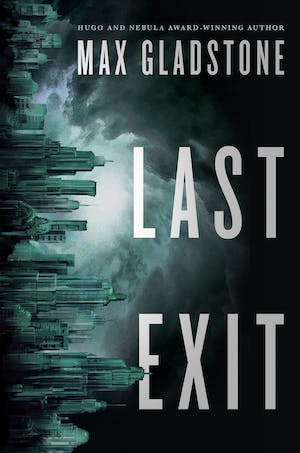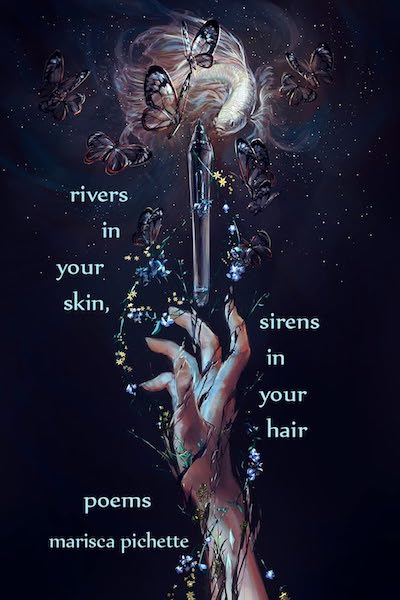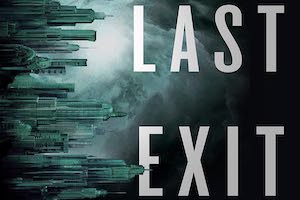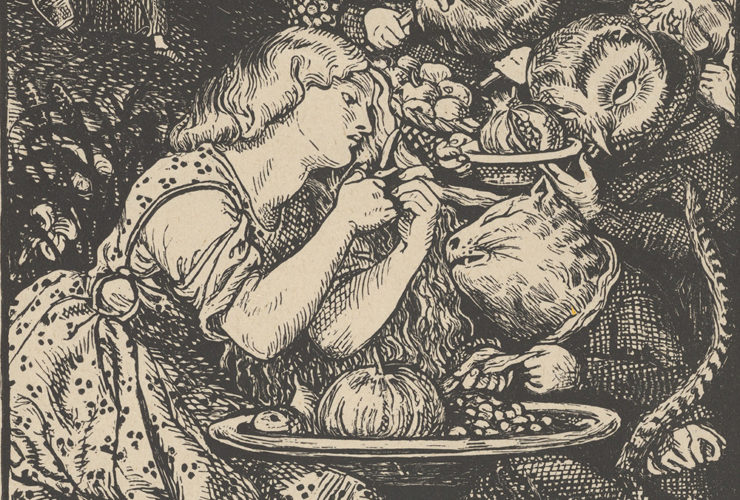Welcome back to Reading the Weird, in which we get girl cooties all over weird fiction, cosmic horror, and Lovecraftiana—from its historical roots through its most recent branches.
This week, we continue Max Gladstone’s Last Exit with Chapters 23-24. The novel was first published in 2022. Spoilers ahead!
Summary
“You and me, we’re gonna ride the whirlwind all the way to Hell or Oz.”
The first time Zelda followed Sal into the Medicine Wheel, she didn’t believe Sal’s contention that the place felt “completely normal.” Now Zelda understands. Though from inside the Wheel seems to stretch on forever—wouldn’t it be stranger not to see everything, not to be able to “greet every being face to face and name it in its own tongue”? Above her, the sky births stars, golden webs, three moons “full, new, gravid, and gone.”
She’s larger here, unfolded. Her strides cross leagues, and she soon approaches the Wheel’s center and the fixed light of the northern Bear. Vertigo-sickened, she stares down “a pit four hundred and thirty light years deep” to a tri-star system. Another step plunges her into storm: a rage of wind, lightning and thunder, music and whale-shapes surging through the dark. Once she thought the storm came from outside, from the rot. Instead the storm lives here, as if “the weight of so much spin, of so many different worlds and might-have-beens, created this vortex.”
Ten years before, a voice on the Wheel-wind asked “What do you seek?” Zelda answered, for “it to be okay.” The answer: “Child, it never is.” Still, she reached Sal and dragged her from the Wheel nearly frozen, arm shredded as if by a barbed-wire hand. Ten years later she turns her spin against the storm of “grief, hunger, blame,” and her skin is too scar-armored for the storm to defeat her. Show me the way, she demands, and—the storm stops, so abruptly that she falls.
A hand reaches toward her—Sal sits in the eye of the storm, not the sky-tall fire-and-shadow Sal but “Sal, before she was lost. Sal, before Zelda failed.” Zelda struggles to figure out how this can be and how to say something that won’t mess things up. Sal speaks Zelda’s name, and they simply embrace.
Everything Zelda’s reading about time travel tells her it’s dangerous to answer Sal’s: “How long?” She answers anyway. “Am I…” Sal asks. Is she dead? No, Zelda says, as she’s always insisted.
Zelda got scared, Sal says. But everyone gets scared, including the Sal Zelda thought so fearless. Zelda’s impulse now is to tell Sal to leave and never think of her again. Instead she tells Sal that she never stopped loving her. Sal replies that she loves Zelda. They’re in this together, and Sal won’t let go if Zelda doesn’t.
It’s not our choice, Zelda wants to say. Out there is a great hungry darkness, and love won’t “blunt its teeth.”
“I’m scared right now,” Sal says. And why not, with the eye of the storm closing in. Zelda clings to Sal, silently begging the moment to be forever, for them not to have to face what comes next, ten years back. Don’t let Zelda fail, don’t let Sal change, let them stay together, holding each other.
* * *
Ramon wakes to a storm that shakes the Challenger. Zelda should have warned him it was coming, but she always meant to enter the Wheel alone, didn’t she? The Challenger responds I told you so. Ramon can’t trust anyone out here, it insists, and he’d rather have his cozy life back home than the truth. Zelda knows he’s not fit to follow her. Does he think he can help her now, struggling in the tempest inside the Wheel? No, says the Challenger: “she wins or dies. That’s America.”
Nevertheless, he struggles into the Wheel and lets his knack lead him one step at a time to Zelda. He had faith once in his power to fix things. He had faith Zelda would always know what to do. Now he believes if there’s a cosmic design, only a “vast and utterly alien consciousness” could apprehend it. That said, there’s some gravity to it all that led them together by the intent of will, care, love.
He finds Zelda and carries her out along a stone-delineated spoke. Emerging from the Wheel, he steps into dawnlight. The sky’s clear, the Challenger half-covered in drifted sand. Three riders approach on dead horses: two women and, unmistakable, “the bulk of Ish.”
* * *
Ten years before, after Zelda pulled Sal from the Medicine Wheel, they huddled in one sleeping bag, Zelda desperate to warm her lover. Sal was like ice, but even asleep she smiled, happy. Zelda lay awake, wondering if their capital-Q Quest would ever lead to an end: the treasure, the grail. The crossroads was still far away, if it existed at all outside their needs and desires.
The night silence was broken by the jingling of silver bells, too melodious to belong in the rotting alts. Zelda looked toward their ashed-over campfire where the air twisted as if someone was hitching in. What appeared was a woman in white on a white horse. The woman was about Zelda’s age, and she fixed on Zelda a wise, gentle smile.
“Do not be afraid,” she said. “Long have I sought you, and we have much to do.”
This Week’s Metrics
Fighting the Cowboy: Continued creation of Terra Preta in the Amazon. If you don’t know about Terra Preta, you’re one of today’s lucky 10,000!
Libronomicon: Is there advice to the reader in Zelda’s wish to pause time with Sal alive “like a sentence is when you close the book and put it down and never read the next”?
Weirdbuilding: Zelda may be genre-savvy about time travel, but that doesn’t make her behave any differently when talking to Younger Sal.
Madness Takes Its Toll: Zelda has faced the cracks in the world before, and “the madness there.” So she’s very sure she can make her way through the storm within the wheel, and make it “bow to her.” I’m not sure that’s how any of this works.
Anne’s Commentary
In Chapter 23, Ramon confronts home truths about the human intellect’s limitations in grasping the core nature of the cosmos, its “logic or justice”:
If there was a design to it all, a way the pieces fit, the consciousness that could apprehend it would look vast and utterly alien to his own, all wrong damn angles and higher dimensions, the kind of math professors said that even geniuses would understand for at most fifteen minutes in their whole career, and in those fifteen minutes the question was, how fast can you type.
I tried to type fast enough to record my insights from our first trip inside the Medicine Wheel, which epiphanies lasted for roughly five microseconds—I’m no higher (or even lower) mathematician. Nor am I a vast wrong-angled consciousness, fun though that might be. But since I did type down my impressions, I include them below.
Is the Wheel singular but omnipresent across all worlds by some trick of the altiverse, or is it plural, each world/alt having its own Wheel? Or is the Wheel neither singular nor plural but both?
Say there’s One Wheel to Rule Them All, if ruling is what the Wheel even does. We could think of an omnipresent Wheel as having a site-specific iteration in each alt. I first visualized an infinitely expansive Sphere. Its interior holds the One True Reality (OTR). On its surface, percolated from the OTR, are an infinite number of bubbles or buds, each a discrete world/alt/possibility. All buds remain connected to the Sphere and communicate with the OTR interior.
Or to stick with the Wheel metaphor. Picture an infinitely large wagon wheel, with an infinite number of spokes radiating from the central hub to the outer rim. The hub would represent the One True Reality, the rim (like the surface of the Sphere) an interface with the Not-Cosmos (see below.) The spokes, then, are analogous to the Sphere buds, site-specific iterations of the OTR, one per world/alt/possibility. All the spokes connect to and communicate with the OTR hub.
Beyond the surface of the Sphere or the rim of the Wheel is the Not-Cosmos, call it a second OTR. This would be the Outside, the Realm of Rot—maybe the home of that utterly alien consciousness Ramon supposes capable of apprehending the design of it all. As it’s in contact with Sphere-Skin and Wheel-Rim, the Outside can infect their bud/spoke iterations; via these iterations, the Outside could conceivably infect the Sphere-Interior and Wheel-Hub. Which would suck.
Or would it? We’re not sure the Outside is Totally Evil. In the end, Sal experienced it as ecstatic revelation….
Maybe I didn’t type fast enough after all, because I bogged down in confuddlement at this point. What are Zelda’s impressions of the internal anatomy of the Wheel? First, that its interior is as big as the world. Second, that her vision expands not only to encompass its expanse but to see every being in it. Third, that she herself expands as if bursting free from a larval shell. It’s a euphoric experience until she nears the center of the Wheel. There a “pit” descends light years to a triple-star system—the actual location of the alt where she and Ramon are camped, or of the alt she needs to find? Her sense of normality becomes a crushing sense of alienation, and she plunges into storm.
She used to think the storm came from outside the Wheel. Now she realizes the storm “lives” in the Wheel, a vortex manifested from all the grief and spent spin of ruined worlds. With the road-scars accumulated over ten years, Zelda’s sufficiently armored to fight through the storm to the very center of the Wheel.
The Wheel, she’s believed, is the same in every alt, every point of time. This trip in, she leaps to a new comprehension of the Wheel as infinitely layered. Other worlds exist within the storm-vortex, but they’re “written” in languages she doesn’t know, scribbles without meaning.
The language that she can read, the heart of Zelda’s Wheel, is Sal—unchanged, unlost, unfailed. It’s as if the Wheel, having asked what Zelda seeks, provides it. Zelda wants it to be okay, and “okay” for her is Sal, dauntless.
Chapter 23 ends in story present. Chapter 24 opens in story past: Having rescued Sal from the Wheel, Zelda is clueless about their next step forward, unsure the crossroads even exist. It’s time for the cavalry to gallop in, right? No, nothing so noisily dramatic. Scratch the bugles; ethereal silver bells will do. Scratch the troop of lathered horses; a single horse, immaculately white, will do, ridden by a very Galadriel of a white-clad woman, young but ages-wise, immune to all earthly stainage. She even speaks in high-fantasy fashion, eschewing “I’ve been looking for you guys forever” to “Long have I sought you.”
The princess, I presume! It looks like the White-Hat Cowboy has a counter in the White Lady of Elsinore, on a White Palfrey to boot! It remains only for those Whales cruising the Wheel-Storm to be White, proper avatars of natural/supernatural Malice or at least Indifference.
Yes.
Ruthanna’s Commentary
The Wheel is present in every alt. The wheel is a gorgeous inversion of the eldritch: it’s everyday experience that feels uncanny when compared to the all-encompassing perceptions within. The wheel’s spokes point to north stars, personal or astronomical. There are a lot of things in this book that claim to represent the really real; only the Wheel makes a persuasive case.
Which is ironic since it’s one of the few things that doesn’t take on anthropomorphic form to argue for itself. This is the first point at which it’s really struck me, for example, that the Challenger’s voice isn’t just Ramon’s internal monologue, but an actual entity in its own right—possibly the Cowboy. Or at least a near relation: what’s as American as guns, if not cars? Which puts a whole new light on the Challenger’s insistence that Only The Road Is Real. On this read, those claims are less Ramon’s own self-doubt and self-sabotage, and more the negging that keeps him in an abusive relationship with a genius machina. What happens, I wonder, when Ish’s firearm meets up with Ramon’s vehicle?
I wonder a lot of things, in fact. Maybe it’s the inevitable result of spending a chapter in close proximity to the heart of the really real: it’s increasingly obvious how much I don’t know. For example:
- In a place where all times are one time, are temporal paradoxes actually a thing we need to worry about? If so, did we just get one?
- Why does Zelda insist Older Sal is being tortured, given that Older Sal seems pretty happy (if pointy) whenever we encounter her?
- Are we about to learn the deal with Elsinore?
- If the gang really did make up the Crossroads, does that mean they aren’t there? (If the U.S. really did make up the nightmare alts, does that mean you wake up after getting eaten by a cannibal zombie? I suspect no, on both counts.)
- If Zelda planned “so much to do” with the woman in white ten years ago, what happened after that? And if that woman’s the Princess, what’s she been up to this past decade?
And et cetera. This is a master class in peeling away layers of assumption: from the reader, from the characters, from the genre(s). I know less than I thought I did at the beginning, but that’s the beginning of wisdom, right? No one ever says what the completion of wisdom involves. Probably more not-knowing, grumble.
This is such a big part of what Zelda and Sal struggle with: both are afraid to admit to not-knowing, and both want desperately for the other to deserve her pedestal. There would be real potential for a mature relationship there, someday, if they hadn’t tumbled into the sort of adventure that makes pedestals plausible. And so here’s Sal, sitting at the heart of the Wheel, torn in a tug-of-war between Zelda and Zelda. And here’s Zelda, torn by desire for Sal-who-was and fear/desire/repulsion for Sal-who-is. An endless moebius strip of mutual tug-of-war, drawing the universe forward.
Zelda feels a kinship with the Wheel, caught in a storm of grief. This seems both accurate and arrogant. The heart of reality is grieving for apocalyptic loss: not some nightmare-alt but the bone-foundation that the Cowboy seeks to deny and celebrate all at once. Survivors building in the ashes, making space amid those who did the burning, isn’t as cinematic as Mad Max stitchmouths—but it’s what every one of those nightmares is built to elide. Zelda doesn’t fully grasp it even walking the storm.
Maybe none of them grasp it—or they wouldn’t be so anxious to pull each other back from the center. After all how else, other than turning a wheel, are a gang of adventurers likely to finally make a revolution?
Next week, Nadia Bulkin’s “Seven Minutes in Heaven” asks why one world survives while the next one over dies—a pressing question for any alt-rider. You can find it in Nick Mamatas’ Wonder and Glory Forever anthology.













